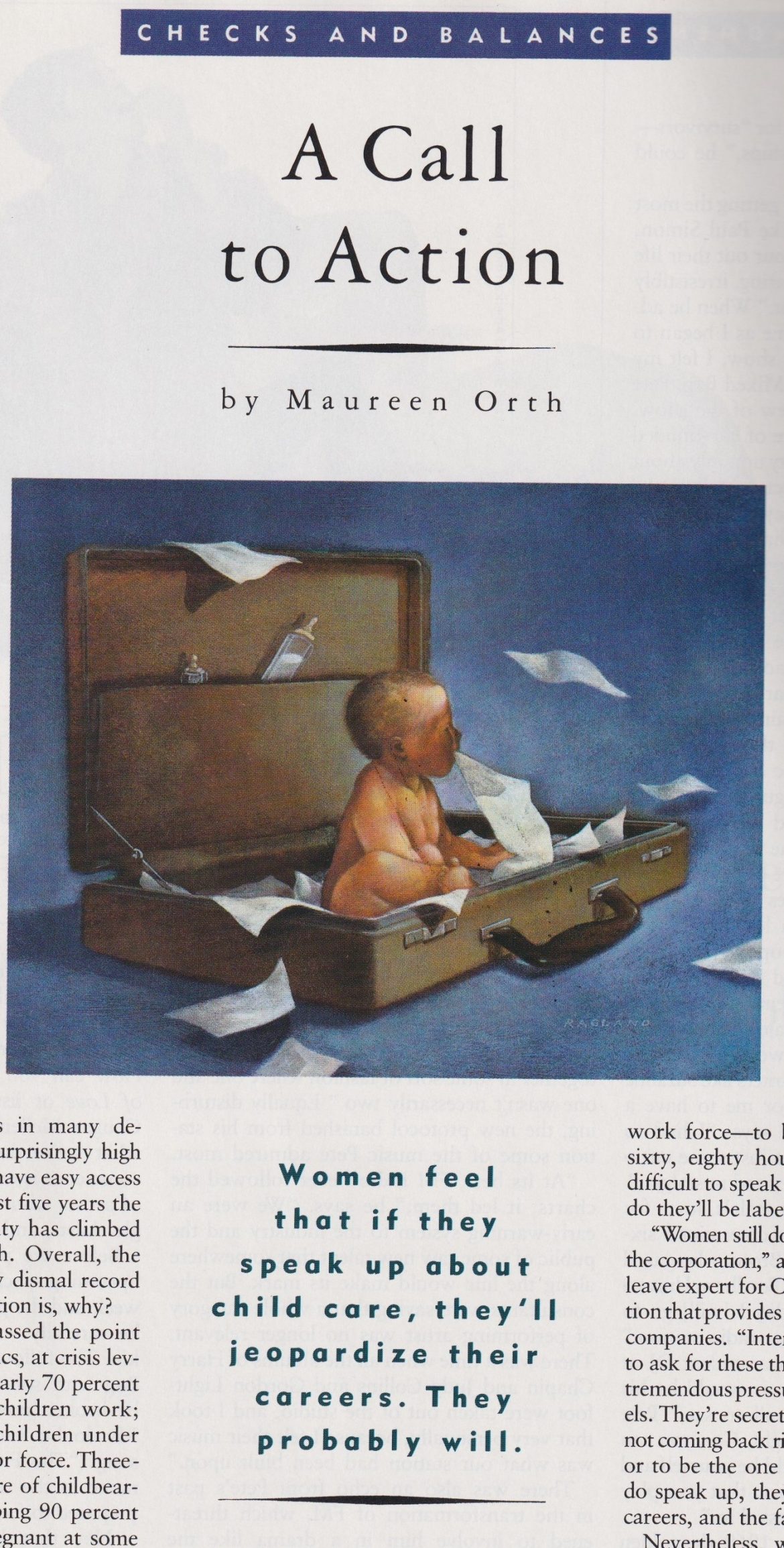Original Publication: New York Women – November, 1988
After years as a political wallflower, child care is suddenly a very sexy issue. Front page stories are now the norm, and both the Democrats and the Republicans are trying to claim family policy as their domain. What a joke.
By nearly every economic indicator, America is supposedly the most advanced country in the world, and the American woman among the most liberated. But when it comes to child care, America ranks right up there with, say, white South Africa, which, unlike the European nations and the USSR, doesn’t have maternity leave either. Moreover, a recent study showed that American women have far more abortions than their counterparts in many developed countries because a surprisingly high number of women here don’t have easy access to birth control. And in the last five years the U.S. ranking in infant mortality has climbed from fourteenth to nineteenth. Overall, the American woman has a pretty dismal record of protecting herself. The question is why?
Certainly by now we’ve passed the point of critical mass, and the statistics, at crisis level, are practically a mantra: nearly 70 percent of mothers with school-age children work; more than 50 percent with children under the age of five are in the labor force. Three-quarters of working women are of childbearing age (16-44), and a whopping 90 percent of them expect to become pregnant at some point in their lives. The vast majority of women work today not purely by choice but because one paycheck does not support the family. Yet American Demographics reports that a scant 5 percent of U.S. employers offer so much as counseling and referral services on child care, let alone direct financial benefits.
When the New York State Commission on Child Care conducted a survey of businesses statewide in 1986, its report pointed out that “corporate decision makers are unaware of the need for child-care support or the way in which a company might respond… Furthermore, employees rarely speak up about their child-care problems. The workplace has generally fostered the belief that personal problems should be left at home.”
“There has been and continues to be tremendous resistance to this kind of change by corporations,” says Barney Olmsted, co-executive director of pioneering San Francisco consulting firm New Ways to Work. “These benefits run counter to the ethic that has prevailed for a long time in the work force — to be a success you work fifty, sixty, eighty hours a week. Women find it difficult to speak out against it because if they do they’ll be labeled a ‘traditional female.’”
“Women still don’t know what to expect from the corporation,” adds Margret Meiers, parental-leave expert for Catalyst, a nonprofit organization that provides research to many Fortune 500 companies. “Internally they don’t know how to ask for these things,” she says, “There is still tremendous pressure for women to be role models. They’re secretly terrified to be the only one not coming back right away from maternity leave or to be the one to go part time first. If they do speak up, they feel they’ll jeopardize their careers, and the fact is, they probably will.”
Nevertheless, women have got to face the “anatomy is destiny” issue far more forthrightly than they do now or the situation will never improve. Already a two-tier system has emerged in law– a “mommy track” for women who want to work a mere forty hours per week, and a far more lucrative and prestigious partnership track for those willing to be on call around the clock– which is the way male partners whose wives stay at home to care for the children have always done it. As it is, in today’s work force pregnancy is defined as a disability, “not as the best ability we have,” says Marie Wilson, of the Ms. Foundation for Women. “We have to face it– our needs are different.”
But why hasn’t the rest of the world– business and government– faced this fact and gone beyond rhetoric? Amazingly, considering the numbers involved, relatively few companies have bothered to analyze whether adding child-care benefits would ultimately save them in terms of higher productivity and less absenteeism – as so many companies who’ve added the benefit have found to be true. They could set up child-care-fund accounts that allow employees to deposit up to $5,000 in pretax earnings to pay for child-care expenses. It’s a tax break that costs employers next to nothing, and here in New York, companies such as Chemical Bank, CBS Records and American Express have set up such funds. But the true mode of the moment is downsizing.
“Because of foreign competition, companies are trying to reduce their cost of doing business,” say Linda McFarland, a partner at Hewitt Associates, a consulting firm for employee benefit programs. “I haven’t seen anybody add a benefit in a long time.” This ignores the reality that we will be facing labor shortages in the next decade because of the baby bust generation just can’t provide enough live bodies and that the majority of the workers entering that shrunken labor pool are expected to be women. “I read about the labor shortage argument, and it makes sense with so many women in the workforce,” adds MacFarland, “but family needs run slam up against the need to reduce costs. I don’t know what happens when those two forces collide. There’s economic power behind both arguments.”
So far, the need to reduce costs — or sheer inertia — is winning out. When Catalyst commissioned studies on parental leave in 1980 and ‘84, the majority of companies surveyed claimed they were willing to try job sharing or allow part-time work. But in the four years between the studies there was no change in the number of firms offering such options. “They say they are open to providing flextime,” says Meiers, “but they aren’t developing policies on it.”
Ultimately, asserts McFarland, “it’s a societal issue. Right now it will be a company issue until it’s big enough to be a governmental issue. We’ll all have to pay so standards will apply more broadly. Why should companies with employees who have children under the age of six have to pay more to operate than those companies who don’t?”
There will have to be a change in some basic American values to rally broad support for a government initiative. “Americans have been very resistant to acknowledge that government has any role or responsibility for children, particularly children who don’t come from poor families,” says Columbia University political science professor Ethel Klein. There is evidence, however, that this societal shift is taking place. A June poll for KidsPac, a political action committee, found that 60 percent of respondents cared deeply that a presidential candidate address child-care, health, and education issues– up from 47 percent just a year ago. Even so, the myth of traditional motherhood dies hard. “The question of when a personal problem becomes a public responsibility is at the heart of society’s ambivalence toward child-care support,” says Dana E. Friedman, senior research associate at the Work and Family Information Center of the Conference Board, which advises businesses on public policy.
Every time there had been a concerted effort to pass child-are legislation– in 1971 Congress did pass a Comprehensive Child Development Act far beyond anything being proposed today– the right wing has come out in droves and denounced “the sovietization of American youth.” Yet it would be a mistake solely to blame the right for the failure to develop effective child-care policies in this country. I clearly remember one of my first journalistic assignments– to find out why the 1971 bill (which had more than 100 Democratic and Republican cosponsors) was vetoed. I found that liberals and feminists shared the blame. The legislation would have given parents the option of placing their two-and-a-half-year-olds, and sometimes even younger children, in facilities that offered education, nutrition, and health programs– and it would have provided prenatal counseling. For the poor, everything would have been free; the middle class would have paid according to income.
A powerful liberal alliance emerged: the late chairman of the House Education and Labor Committee, Kentucky’s Carl Perkins, and Marion Wright Edelman, then as now godmother and leader of the child-care lobby, helped kill the bill because neither wanted states to have a role in the allocation of funds. (Edelman worried that Head Start monies distributed in the South through white state governments would never make it to poor black children.) Both wanted the aid to go directly from the federal government to the local level. When they got their way, much of the Republican support faded, and Nixon, eager to pacify the right on the eve of his first trip to China, suddenly had a reason to veto the legislation. Ironically, block grants to states for child-care legislation are now the cornerstone of a proposed Democratic bill. Edelman was unavailable for comment, but an associate of hers at the Children’s Defense Fund, Amy Wilkins, says that timing was everything: “We don’t think we made a dramatic mistake in 1971. States have matured [since then] in their delivery of child-care services.”
And where have the “professional” feminists been throughout this debate? The women’s movement never made any noise about this at all,” says Jack Duncan, former majority counsel for the 1971 bill on the House side. Says Columbia’s Ethel Klein, “[Feminist] women were very concerned about separating women from children, as in ‘women and children first.’ There is an adult individual male, there is no adult individual female; she is a wife and a mother. But by rejecting the family so strongly, they gave their issue to the right.”
Today, because of sheer economic necessity, the banner of motherhood finally seems to have been snatched from the stranglehold of Phyllis Schlafly and her “buggy brigades.” But no one should be fooled into thinking that either the Democratic Act for Better Child Care, which allocates $2.5 billion to help states provide child care for lower-income families and establish national standards for that care, or George Bush’s $2.1 billion proposal to give poor parents with children under age four a $1,000 tax credit, is going to come anywhere near solving the child-care dilemma we face in this country. (As we go to press neither proposal has come before Congress for a vote, nor has a bill mandating ten weeks of maternity leave for the 40 percent of working women currently protected by a benefit package.) At the very least, government can create a more hospitable climate for further initiatives by the private sector. It can provide a good example as an employer itself. And it can set a moral tone for business to follow that, one hopes, will help the millions of parents now forced to lie when they arrive late or leave work early because their children need them.
To date, in New York, with so many corporate headquarters and so many service-based industries employing so many women, not one CEO has taken up the issue of child care and made it his or her baby. “There has to be a vast partnership of government, business and parents,” says Dee Topol, a vice president who oversees many of American Express’s child-care programs. “So far, we’ve only got the parents.”
Just barely. The fact remains that as long as women continue to behave, when at work, as if their child-care needs don’t exist, current conditions will prevail. “Without personal experience, management remains insulated from the need for child-care support and its impact on work performance and the bottom line,” states the 1986 report for the New York State Commission on Child Care. Nor is there any guarantee that female executives, when and if they reach the top, will change anything. “The first wave of women bosses may feel they have to play the masculine role to the hilt,” says Caroline Zinsser, director of the Child Care Policy Study at the Center for Public Advocacy Research. “Women who have gone through a difficult experience themselves might believe that everyone else ought to go through it, too, as a rite of passage.” Nevertheless, Zinsser adds, “I can’t believe a woman who’s really good at her job can’t speak up. We all know how hard it is to find top-quality people.”
Isn’t it about time working mothers and mothers-to-be realize they’re paying an enormous price for their silence? The ancient query of that old sexist Freud applies: What do women want?
This article is typed from the original material. Please excuse any errors that have escaped final proofreading.



